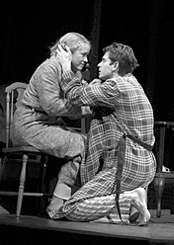Article
The Loman Family’s Lessons for the Old Psychiatrist
Author(s):
In our current age of increasingly biological psychiatry, psychiatrists seem to be paying less and less attention to the humanities, even as internists and surgeons are paying more attention.

Attention must be paid!
-Linda Loman in Death of a Salesman
I hope a good many of you read the Resident’s Blog on April 18th by Howard Forman, MD, on The Loman Family’s Lessons for the Young Psychiatrist. What gratification, admiration, and inspiration it was to have a young psychiatrist recognize the importance of the humanities and be so moved by seeing the play. In our current age of increasingly biological psychiatry, psychiatrists seem to be paying less and less attention to the humanities, even as internists and surgeons are paying more attention. So this gives me hope for the next generation of psychiatrists. I would not be at all surprised if Dr Forman eventually became a leader in our field, as he has become for the Resident’s Blog.
This play, Death of a Salesman, being given a revival of much attention on Broadway, is on its way to becoming a timeless classic. It seems to be a play that reveals new and important meaning to every person and which seems different each time one sees it over a lifetime. Many general chords may resound: the promise and perils of families; the “pulling” (as my wife puts it) of mothers (and now, increasingly, fathers) toward children, spouse, and outside work; the benefits and drawbacks of new technology; and the value of every individual in a community. The current director has conveyed that he thinks the father-son relationship or, in our terms, the Oedipal conflict, is at the heart of the play. Before Freud and modern psychiatry, insights into our human nature came out of the great literature of history, such as the Old Testament and Shakespeare.
Though Dr Forman wrote, “all the preparation was for naught,” obviously it was not. Once he recovered from his overwhelming emotional reaction, so promising an indicator of his therapeutic empathy and compassion, Dr Forman focused on some psychiatric perspectives. He considered possible diagnoses for Willy Loman, all the while recognizing, I believe, the temptation and risks of diagnosing without personally evaluating someone. He also had the humanistic insight that psychotherapy should be available to anyone in need.
While I was at the APA meeting in Philadelphia, I also had the good fortune to see the same play. I had read Dr Forman’s blog beforehand and couldn’t help but wonder what the lessons might be for an old psychiatrist like me, who had seen the play at least twice before. There were many. I realized that I was now more affected by Willy’s son Biff than the salesman himself. Although that could have been from the performances themselves, I suspect it might have had more to do with the fact that I am now Willy’s age. I was filled with gratitude that I am close to a retirement of choice, with I hope enough financial resources. I am also relieved that my children have been doing well (“knock on wood”), in contrast to the failures of Willy’s. Psychiatrists have a particular challenge not to inappropriately and narcissistically use their knowledge at the expense of being a “normal” parent.
I now also wondered whether Willie might also be depicting some early dementia. This time around that reminded me for the first time of my own father. While I was in the beginning stages of my own psychiatric career, my father had trouble paying enough attention at work. Depression, but not dementia, was the main consideration.
Although the play may be timeless in a literary sense, it is not in a psychiatric sense. In 1949, when it was first produced, psychiatric treatment was very limited. In the last half century, many new psychotherapies besides Freudian have emerged and, of course, virtually the whole development of psychopharmacology. So, a psychiatrist who has been through many of these developments can’t help but wonder whether Willy’s suicide could have been prevented. Has our modern public education for recognizing suicide risk been successful enough to help someone like Willy’s wife and neighbor to intervene before Willy tried and then committed suicide? Psychiatry now has a less antagonistic relationship to religion. Although Willy does not have any apparent religious affiliation, if he did, could clergy have provided him with more meaning for his life and a path to forgiveness? Even though he didn’t have enough funds to self-pay, if he were willing, would he now be one of the insured that could obtain adequate evaluation and treatment? Would an antidepressant and/or medication for dementia be beneficial? Certainly, family therapy, as well as individual therapy for Willy and his two sons, seems indicated, does it not?
Then we have our current ethical principle to advocate for the betterment of our community. How can seeing this play not remind us of this principle in our time of economic downturn and increasing suicides? How can we ignore the “Occupy Wall Street” movements and the desperation of the increased numbers of our jobless and over-mortgaged? There must be so many Willy Lomans out there today, the low men and women in our world. Dr Forman recognizes that; so must we all.
These two blogs by Dr Forman and myself are by two male psychiatrists, albeit at different points in our lives. Dr Forman also rightly recognized that the perspective of female psychiatrists might be much different and very valuable to have.
Are there any female psychiatrists who care to share their perspective? What else should we be paying attention to?





